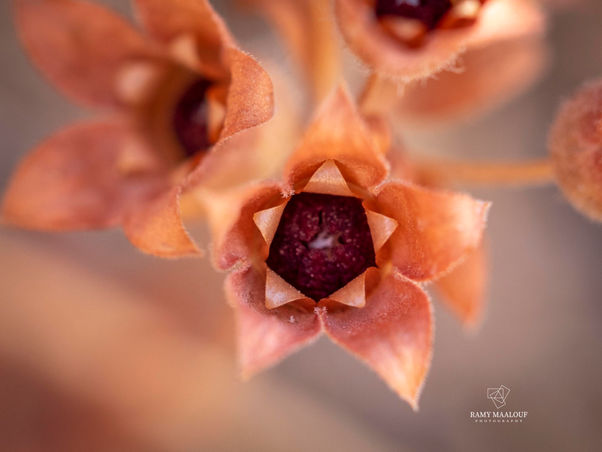Family |
Primulaceae
Androsace maxima
L.
Androsace maxima L.
First published in Species Plantarum: 141 (1753)
(Nouvelle Flore du Liban et de la Syrie, vol. 2, Pl. XCVIII nº 4; 1969)
• Life-form & habit: Annual, forming a small basal rosette; stem extremely short or absent. Whole plant often appearing as a compact tuft 3–10 cm across. Surfaces minutely pubescent.
• Leaves: Rosulate; oblong-oblanceolate, 1–3 cm long, obtuse, slightly tapering at the base; margins entire or faintly scalloped; upper surface glabrous or sparsely hairy, lower surface more distinctly pubescent.
• Inflorescence & flowers: Scapes 2–10 cm, bearing small, few-flowered umbels. Pedicels unequal, elongating in fruit. Bracts linear. Corolla white or pinkish, with a yellow throat; lobes rounded, 2–3 mm. Calyx campanulate with 5 acute teeth, distinctly exceeding half the length of the tube.
• Fruit: Capsule subglobose, included within or slightly exceeding the calyx; seeds smooth, oblong.
• Phenology: February – April.
• Habitat & elevation: Open fields, steppe margins, foothill slopes, and disturbed ground; from lowlands to lower montane zones.
• Lebanese distribution: Recorded by Mouterde from lowland and inland regions including Beirut, Antélias, Nahr el-Kelb, Tripoli, Sin el-Fil, Baabda, Baalbek sector, Zahlé, Chtaura, Niʿmeh, Dahr el-Baïdar, and the Marj plain.
• Native range:
Afghanistan, Algeria, Altay, Austria, Bulgaria, Buryatiya, Central European Russia, China (North-Central), Chita, Cyprus, Czechia–Slovakia, East European Russia, France, Germany, Greece, Hungary, Inner Mongolia, Iran, Iraq, Irkutsk, Italy, Kazakhstan, Kirgizstan, Krasnoyarsk, Krym, Lebanon, Syria, Libya, Mongolia, Morocco, North Caucasus, NW Balkan Peninsula, Palestine, Romania, Saudi Arabia, South European Russia, Spain, Switzerland, Tadzhikistan, Transcaucasus, Tunisia, Turkmenistan, Tuva, Türkiye, Türkiye-in-Europe, Ukraine, Uzbekistan, West Siberia, Xinjiang, Yakutiya (POWO).
• Introduced into: New York (POWO).
• ⚠️ Taxonomic note: Distinguished from A. villosa and A. septentrionalis by its annual habit, small rosette, and short scapes with few-flowered umbels. The calyx teeth are comparatively longer and more acute than in other Levantine taxa.




